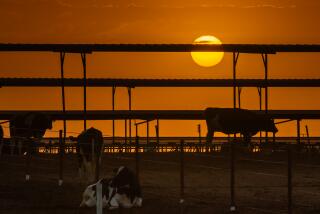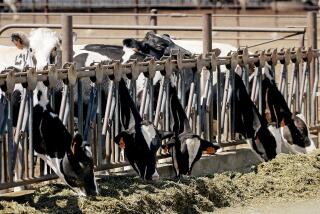Buffalo make the mozzarella
- Share via
BANGOR, CALIF. — Cars screech to a halt when they round a bend on a rural road in the remote Northern Sierra foothills and Hanns Michael Heick’s 200 water buffalo come suddenly into view.
The buffalo are the main ingredient in Heick’s quixotic quest to produce the finest mozzarella cheese this side of Naples and crack Italy’s monopoly on that high-end specialty product.
“There was a point in my life where I didn’t even know water buffalo existed,” said Heick, who was born in Vienna and spent much of his adult life as a wine exporter. “Now I’m an expert.”
True mozzarella is made from the water buffalo’s rich milk, the fattiest among domesticated animals. The result is said to be silkier and tastier than mozzarella made from cow’s milk.
For years, mozzarella di bufala flown in from Italy was the only option for U.S. gourmets and chefs. The freight charges can exceed the cost of the cheese itself, which fetches upward of $20 a pound. But unlike other cheeses that improve with age, mozzarella is best served soon after being made.
Hoping to fill the demand for the cheese -- and to capitalize on a $48-billion specialty food trend sweeping the U.S. -- Heick and his Italian-born wife, Grazia Perrella, began making mozzarella, which his wife’s family has produced for three generations. Theirs is the larger of two mozzarella-producing water buffalo dairies in the U.S.
Their company is named Bubalus Bubalis, the Latin name for the species.
“There’s a developing market in the Unites States,” Heick said as he ate a slice of mozzarella and tomatoes drizzled with olive oil. “Children love it, too.”
The average American ate 10 pounds of mozzarella last year, twice the consumption rate of a decade ago, according to data compiled by the University of Wisconsin. But nearly all of it was made from cow’s milk and manufactured by a handful of large dairies that are driving down cheese prices even as production increases. This is putting the squeeze on small cheese makers, prompting many of them turn to gourmet niches that command premium prices, said Robert Aschebrock, a cheese consultant.
A retired U.S. Department of Agriculture dairy expert, Aschebrock first tasted Heick’s cheese last year as chief judge of the U.S. Championship Cheese Contest in Milwaukee.
“It’s much smoother and creamier than cow’s milk mozzarella,” he said, although the cheese wasn’t formally entered in any category and so didn’t win any awards.
For centuries, Italian cheese makers have dominated the gourmet mozzarella market, largely because of the domestication of large herds of imported water buffalo in the days of Da Vinci. How and when the water buffalo -- commonly used as beast of burden in its native Asia -- got to Italy is a mystery.
So far, Heick is managing to squeeze out $1 million in annual sales, an increase from the $350,000 the dairy took in four years ago.
“If we had more milk, we could sell much more cheese,” said Heick, who plans to expand the herd in Bangor to more than 600 head in the next few years.
Still, the dairy is a long way from profitability, held down by the expenses of an operation that is now spread across California at three locations. The “dry herd” roams Bubalus Bubalis’ 50-acre Butte County ranch, while those ready for milking are shipped to San Bernardino. The milk is taken to Gardena for processing.
By this time next year, Heick said the entire operation would be located at the Bangor site, which is being outfitted with new refrigerators, pasteurizing machines and all the other equipment needed for a dairy. He’ll then work to improve on the annual mozzarella output of 150,000 pounds a year, a pittance compared with the 2 billion-plus pounds of cheese churned out annually in California.
In the meantime, Heick is attracting a small but growing following at farmers’ markets, high-end grocers and restaurants across the country that order direct.
“Customers can’t believe the quality of it,” said David Gilbert, co-owner of the Old Yellowstone Garage restaurant in Jackson Hole, Wyo. He orders 15 to 30 pounds of Heick’s cheese a week and uses it on lasagna, pizza and other dishes. “It’s comparable to what’s shipped from Italy,” Gilbert said.


